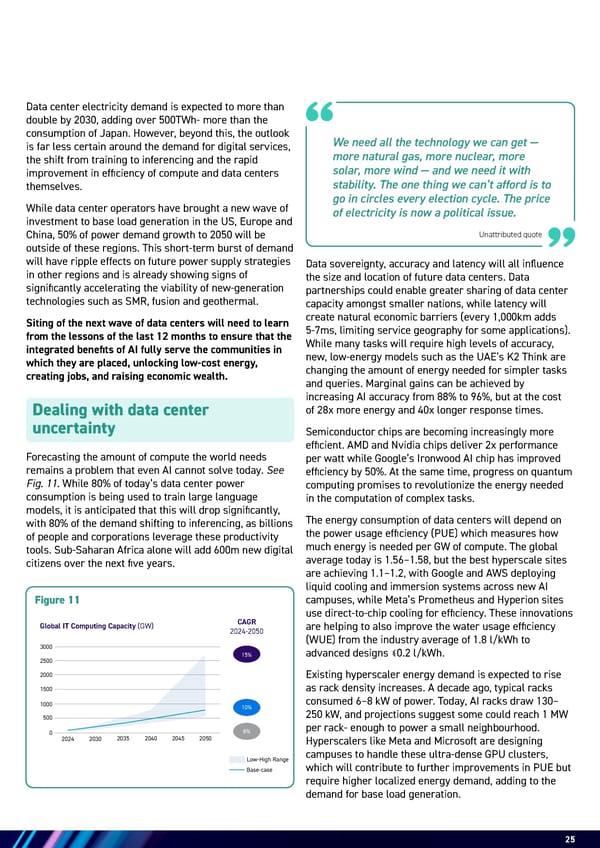25 Figure 11 Data center electricity demand is expected to more than double by 2030, adding over 500TWh- more than the consumption of Japan. However, beyond this, the outlook is far less certain around the demand for digital services, the shift from training to inferencing and the rapid improvement in efficiency of compute and data centers themselves. While data center operators have brought a new wave of investment to base load generation in the US, Europe and China, 50% of power demand growth to 2050 will be outside of these regions. This short-term burst of demand will have ripple effects on future power supply strategies in other regions and is already showing signs of significantly accelerating the viability of new-generation technologies such as SMR, fusion and geothermal. Siting of the next wave of data centers will need to learn from the lessons of the last 12 months to ensure that the integrated benefits of AI fully serve the communities in which they are placed, unlocking low-cost energy, creating jobs, and raising economic wealth. Forecasting the amount of compute the world needs remains a problem that even AI cannot solve today. See Fig. 11. While 80% of today’s data center power consumption is being used to train large language models, it is anticipated that this will drop significantly, with 80% of the demand shifting to inferencing, as billions of people and corporations leverage these productivity tools. Sub-Saharan Africa alone will add 600m new digital citizens over the next five years. Dealing with data center uncertainty Data sovereignty, accuracy and latency will all influence the size and location of future data centers. Data partnerships could enable greater sharing of data center capacity amongst smaller nations, while latency will create natural economic barriers (every 1,000km adds 5-7ms, limiting service geography for some applications). While many tasks will require high levels of accuracy, new, low-energy models such as the UAE’s K2 Think are changing the amount of energy needed for simpler tasks and queries. Marginal gains can be achieved by increasing AI accuracy from 88% to 96%, but at the cost of 28x more energy and 40x longer response times. Semiconductor chips are becoming increasingly more efficient. AMD and Nvidia chips deliver 2x performance per watt while Google’s Ironwood AI chip has improved efficiency by 50%. At the same time, progress on quantum computing promises to revolutionize the energy needed in the computation of complex tasks. The energy consumption of data centers will depend on the power usage efficiency (PUE) which measures how much energy is needed per GW of compute. The global average today is 1.56–1.58, but the best hyperscale sites are achieving 1.1–1.2, with Google and AWS deploying liquid cooling and immersion systems across new AI campuses, while Meta’s Prometheus and Hyperion sites use direct-to-chip cooling for efficiency. These innovations are helping to also improve the water usage efficiency (WUE) from the industry average of 1.8 l/kWh to advanced designs ≤0.2 l/kWh. Existing hyperscaler energy demand is expected to rise as rack density increases. A decade ago, typical racks consumed 6–8 kW of power. Today, AI racks draw 130– 250 kW, and projections suggest some could reach 1 MW per rack- enough to power a small neighbourhood. Hyperscalers like Meta and Microsoft are designing campuses to handle these ultra-dense GPU clusters, which will contribute to further improvements in PUE but require higher localized energy demand, adding to the demand for base load generation. Unattributed quote 8% 15% 3000 Low-High Range 2500 2000 1500 500 1000 0 2050 10% Global IT Computing Capacity (GW) CAGR 2024-2050 Base-case 2050 2045 2035 2030 2024 2040 We need all the technology we can get — more natural gas, more nuclear, more solar, more wind — and we need it with stability. The one thing we can’t afford is to go in circles every election cycle. The price of electricity is now a political issue.
 Energy & AI: Twin Engines Turbo-Charging Economic Growth Page 24 Page 26
Energy & AI: Twin Engines Turbo-Charging Economic Growth Page 24 Page 26